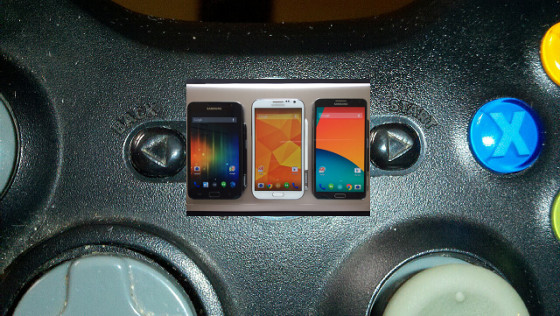7 Reasons Why the Feud Between “Casual” and “Hardcore” Gamers Is Literally Ridiculous
 |
| Image combines the work of ??? and Milad Mosapoor |
For starters, a bit of definition is in order. When I say literally ridiculous, I’m going with the root of the word. Ridicule. A lot of people use the word ridiculous as a synonym for funny or absurd or bizarre. It’s not. Ridiculous refers to something that is worthy of ridicule. Sure, ridicule can be funny, but it doesn’t have to be funny. What it does need to be is cruel and merciless.
That’s the approach I take to responding to comments on the subject of casual games and the people who play them. Computer makers ASUS recently embarrassed the hell out of themselves while trying to market their products by appealing to “hardcore” gamers and feeding into their completely unjustified feeling of superiority to “casual” gamers. Aside from inadvertently looking like sexist prats, they also fed into a false dichotomy that is not only less true than people tend to think, but is actively harmful to gaming as a whole. Here are some examples of why…
7. Gaming Does’t Need Another Stupid, Divisive, Time Wasting, Pissing Contest.
 |
| greyloch |
| I’d put a picture of two people urinating, but Luke would kill me, and sex sells |
Too much of gaming culture is already devoted to pointless arguments. There’s PC vs Console. If you pick consoles, there’s the game of “which one is better” that gets renewed every few years when the new models hit stores. If you pick PC, the question of Windows vs Mac comes up (which isn’t as one-sided a query as it used to be). Then there are petty arguments over which kind of game genres are better or worse. None of these arguments have improved the gaming experience at all.
Even if one thinks casual games are a stupid waste of time, looking down on them doesn’t enhance the enjoyment of more traditional games. For one thing, spending 5 hours playing Skyrim is just as much or as little a waste of time as using the same 5 hours to play a marathon of Angry Birds. As John Lennon once said “Time you enjoyed wasting, was not wasted”. Conversely, I’d argue that time spent being condescending to someone else’s hobby is time wasted, but that’s mostly because I can’t imagine any joy to be found in it.
That’s not to say that there aren’t aspects of casual gaming worthy of criticism, though…
6. The Freemium Model Does’t Have to Be Nearly as Scammy as People Think.
 |
| The Masonic Order made this (or so I’m told) |
| “Ya ever look at the back of a dollar bill? There’s some spooky shit!” |
Probably the most hated and reviled aspect of mobile gaming that has also spread to PC and Consoles is the concept known as “freemium” games, where the product itself is free, but other in-game content needs to be purchased. This is a system that can be horribly abused, as in the case of Dungeon Keeper Mobile, which is a boring slog if you’re not spending any money, but can also produce a game that offers hours of fun for no money at all.
A good example is a little known game called Triple Town, which one of my roommates clued me into a few years ago. It’s a cutesy, fun, match-3 game, where you build little cities by combining items on a small map. Like many freemium games, there are a limited number of moves you can make, which regenerate over time. The Facebook version used to offer an in-game item that gives unlimited moves for about $10.00, which is the only in-game item I’ve ever bought. It basically felt like buying the full version of a game after playing the demo for 3 years. The community aspect was also friendly, in that I could trade power-ups with randomly matched users instead of being pressured to bug my friends. When developer Spry Fox decided to close up shop on the Facebook version so that they could devote resources to creating new games, they gave customers like me a free code to get a copy of the game on Valve’s Steam service. While not having the community element of the Facebook version, it’s the same kind of game in pretty much every other way. It’s also worth noting, that as annoying as I find it that certain levels of various Angry Birds spin-offs are locked behind a paywall, it’s kind of hard to be too upset when the majority of the content in those games is made available to me free of charge.
This is the kind of engaging business model that casual games can expand upon which would be great for consumers and developers alike. It can even spread to PC games. First-person shooters like Loadout and Team Fortress 2 can offer players hours of fun without a single penny being spent. Extra items that can be purchased within the game can enhance that fun, but aren’t necessary for total enjoyment. It’s definitely frustrating to see so many companies eager to nickel and dime their audience at every turn, but the best way to combat that is by voting with our wallets and supporting the guys who treat us well. We should definitely appreciate the people and companies that make fun and simple games, even if we don’t like the particular product. Speaking of simple games…
5. Simplicity Is a Lot More Complex to Create Than Most People Think.
 |
| L. Leslie Brooke |
| I dunno what bricks have to do with video games, but I like this image |
One of the oddest complaints I’ve ever heard about music is friends declaring “That song is so simple” in a tone that conveys not just insult, but universally understood insult. Any time I asked these friends (who were amateur musicians themselves and of decent skill) why it’s a bad thing for a song to be “simple,” there was never a clear answer beyond “anybody can do it” and an insistence that this wasn’t really the case being shrugged off as getting too hung up on semantics.
Whether the instrument used to craft art is a guitar, a drum, a keyboard or an application for compiling lines of code, the plain and straightforward fact is that not everybody can make “simple” art, and not everyone with skill can do it well. For a great example look no further than Three Little Pigs, a story that is somewhere between 1 and 2 centuries old, and will likely outlive everyone reading this article on the day it was published. This story is as simple as it gets, but it didn’t come along until the early to mid 1800s (so far as we know). What this means, is that millions and billions of story tellers across the world and throughout history who thought up stories to tell their kids, didn’t put together the simple elements that resulted in a wolf attacking pigs and succeeding or failing based on what material they made their homes out of. It’s similar to an older tale called The Wolf and the Seven Young Kids which feels like a more complex version of Little Red Riding Hood (which, incidentally, goes back to the 1300s) and is far less memorable than either of the other two “Big Bad Wolf” stories. So while it might seem easy to create something simple, it’s actually a lot harder to create a simple thing that will catch on and stand the test of time.
A short story collection I once read included a bit in the introduction talking about how much harder it is to write a short story than a novel, and how much easier it is to tell a story that requires one novel instead of a series. Getting the details of a tale filtered down to just the essentials and saying everything that needs to be said in the shortest amount of space is a difficult trick to pull off. The same principle applies to video games – even the casual ones. While a level of Angry Birds or Cut The Rope might seem like something anyone with the right software could whip up in a few minutes, there’s a lot of careful work that has to go into figuring out how to make the level challenging, but not too frustrating (or conversely, a level that’s easy without being too effortless). The overall progression of levels from easy to harder has to be plotted out in a manner that keeps the player interested and doesn’t ramp things too far up or down the difficulty curve from one level to the next.
4. If Video Games Are to Be Seen as Art, Casual Games Must Be Included in That Designation.
 |
| Nicolas R?gnier |
| Paintings are like a video game cut scene stuck on pause |
In the past decade or two, video games have been undergoing a crisis of identity similar to what movies and comics have had to deal with before them. Like an adolescent with a cracking voice and peach fuzz on his cheeks who wants the grown-ups to take him seriously, video games have hit the moment where being seen as a lowbrow, disposable entertainment hobby isn’t good enough anymore, and now the creators and consumers of the medium want to see it recognized for the art form that it is.
The path to artistic validity is a long one that we’re still stuck on. The medium has had it’s detractors, most notably Roger Ebert, who after controversially declaring that games can never be art, admitted that he was the wrong guy to determine the answer to that question. The crux of Ebert’s problem comes down to emotional engagement, and that he never felt that with games. His admission that he was the wrong guy to evaluate the artistic status of the medium was cemented by his unwillingness to play enough games to explore the question. In the end, he didn’t want to play video games because he didn’t enjoy them.
As a culture, we’re still stuck on this debate largely because one side enjoys games and the other does not. Splintering this debate even further by deciding which things are and are not video games (which is almost always done through a filter of whether or not people enjoyed the end result) should therefore be seen as one of the worst endeavors for gamers to participate in. The last few years have seen a rise of indie games that wander off the reservation of convention and trek into bold and uncharted territory. Games like Dear Esther and Gone Home have met criticism for “not being games,” but those responses really call for a broader scope of what a game is or can be. For the record, while neither have the conventional trappings of a game, I’m glad to have played them both. I found Dear Esther to be as boring as a bucket of spit, but Gone Home had a story that kept me wanting to know more.
Casual games are just as much a valid expression of art as story driven games or first person shooters. No art form in human history has ever benefitted from limiting what kind of styles and techniques can be greenlit and it’s unlikely that this will ever change. It’s vital that the expansion of great and inspiring casual games are cultivated if video games are to continue to grow…
3. Casual Games Represent One of Many Emerging Evolutionary Paths for Gaming, and Compartmentalizing it Will Only Hurt the Medium.
 |
| Kalpeshzala59 |
| Did you know that evolution is artwork created via biology? |
Growth is probably the defining feature of life, and life is something which both imitates and is imitated by art. Thus, growth is also a defining feature of art. In order to thrive and stay vital, an artistic medium must continue to branch out into new directions and travel down new pathways. For all the people complaining about the glut of superhero movies and the huge amount of fanboy flicks on the way, these films are a result of the growth and evolution of summer blockbusters. In time, they’ll be supplanted by whatever comes along next. My hunch is that one of the successors to superhero movies will be something that comes to be known as “video game bait.” As video games continue to rise up and become a more powerful art form, and Hollywood studios start to realize that a movie turned into a video game offers more potential for greatness than the other way around so long as the schedule is set to the game instead of the film, story tellers will pitch their ideas by making a movie as a “proof of concept” for a game, in much the same way that many modern comics and graphic novels are created as monetized story boards for film projects.
Right now the entertainment industry is still stuck doing things backwards. In the next few years, it’s expected that we’ll see movie adaptations of Assassin’s Creed and Angry Birds, but I can’t really imagine either one being as engaging as holding a controller or a mobile phone and participating in creating the action that happens on the screen. I think it’d be a lot more interesting to test the waters for a new mobile IP by creating a cutesy cartoon movie and then bringing out a mobile game for kids to play afterwards. A film that served as a little bit of a ninja’d tutorial and mostly as an introduction of the world and the story that was then opened up for the characters to interact with and become a part of would be an enriching experience.
The platform of mobile phones and tablets are fairly young in comparison to their brother and sister formats of PC and game console, which aren’t all that old themselves; so it’s still hard to imagine where gaming can go moving forward from here. Browser-based web games have a bit more time in the field, but the advent of social media oriented games on Facebook (and formerly MySpace) are an iteration that feels noticeably different from their kin. Playing a game on Newgrounds (which is generally a solo experience) feels distinctly different from playing on a social network, where all your friends can join in if they so choose. Being able to carry that over onto an Android or iOS device and play the game on the go is a liberating feeling that I, as a customer am grateful for.
For those of you reading who recognize the need for innovation/evolution and don’t like feeling as though you have to select a branch of the tree to stay on, there’s good news for you…
2. No One Has to Choose One Form Over the Other.
 |
| Carly & Art |
| Foxy Gamers can find a way to enjoy more’n one thing. |
In the past few years I’ve been developing a philosophy/art movement that I call “radocaster” as a way to not only recognize the insanity of people feeling forced to choose sides in art, but to fight against it. I feel that anyone who argues about digital photography versus chemical photography is missing the larger point of embracing the entire medium of photography, just as someone getting caught up in Coke vs Pepsi is ignoring the wider tapestry of soda pop itself. Life is too rich and full and splendid to waste away ignoring options and chances that are so varied and wild.
When it comes to video games, there’s no reason that someone can’t enjoy as much of the buffet table as they want. Liking Halo doesn’t stop you from enjoying the newest Mario game, and loving Mario doesn’t mean you can’t like Sonic. Most people I know of who identify as gamers have moved beyond the argument of PC/Console or which console, and (if they can afford it) have multiple systems to choose from. Many homes have Sony, Microsoft and Nintendo systems sharing space in the living room, and a PC or Mac somewhere else in the house as well.
The same thinking applies to casual games and long scale games (a.k.a. non-casual games). When I feel in a “gamey” mood at home, I’ll generally see which of the games I wanna play on my Mac (while lamenting the death of my windows machine that died 2 years ago when I was 3/4 through Assassin’s Creed 2: Etzio Boogaloo) and when I’m riding the bus to work or home and don’t feel like reading a comic, I’ll pull out my “pocket computer”/phone and play something.
The choice of casual or long-scale games might feel like a recent addition to the list of options, but it isn’t. As a sub-medium (for lack of a better term), casual games seem fairly new and recent, but the truth is, upon closer inspection that they’ve been around from the beginning…
1. It’s a Lot Harder to Tell the Difference Than Some People Want to Admit.
 |
| ParaDox and Esteban.barahona |
| Find me a better way to demonstrate ambiguity, I dare you! |
Anyone who loves Tetris and looks down on casual games is a moron. There’s no polite way to say it accurately. The plain and simple truth is that Tetris is and always has been a casual game, just like Pac-Man and Q*Bert. In fact, a huge majority of the arcade classics of yesteryear are casual games that can be played for an idle five minutes or hours on end. They had a built in system of micro payments that involved physical exchanges of cold hard cash for fun.
The tricky part comes in determining which games of the classic era were not casual. Mario Brothers certainly was, but what about Super Mario Bros.? The intuitive answer is that it’s obviously a long-scale game, but for the kids who were pumping quarters into the slots and could happily hand the joystick over to some other kid once they killed the dragon in the first castle, the experience was far closer to casual. Even the manner in which gameplay was broken up felt casual. Each level was sectioned off into four pieces with a beginning and end point and allowing a certain sense of satisfactory progress.
Then there’s the perennial classic Gauntlet, which had most of the major elements of what’s now associated with casual gaming. A seemingly endless progression of dungeons that gets harder and harder as time goes by, with the players hit points draining away even without damage as their characters grow hungry. If Gauntlet had not existed until say, 2011, it almost certainly would have sprang into being on mobile phones or Facebook. The same can be said of Pac-Man and the rest of the gang. In a sense, the casual gaming sub-medium is really just a reemergence of the video arcade in a more portable format. It’s much like the way dinosaurs evolved into birds and esquires turned into sharks. Arcades now exist in our pockets and on the cloud.
Back in the day, gamers had a choice of playing at the arcade or at home, but there wasn’t a need to decide that one form was automatically inferior to the other. The same is true of casual and long-scale gaming. Even if you can’t dig playing a casual game, you should be able to dig how cool they are.
Previous Topless Robot Articles by Greggory Basore Include:
10 Reasons Why An All Female Ghostbusters Reboot is the Best Possible Direction
10 Reasons Hollywood Needs to Stop Catering to Whiny Assed Nerds like You and Me
The 7 Most Amusing Reactions and Possibilities to come from Microsoft Buying Minecraft
10 Reasons I Don’t Blame Robin Williams for Wanting to Die
The 5 Most Frustrating Moments Game of Thrones Season 4 (and 5 Ways to Wait for Next Year)
The 15 Geekiest Shows of Summer 2014
8 Unanswered Questions Left by X-Men Days of Future Past
5 Lessons Hollywood Should Learn from The Lego Movie (And 5 Ways they’ll Miss the Point)
16 Heartbreakingly Awesome bits of production art that never made it to the screen.
